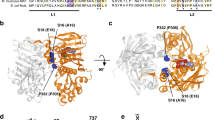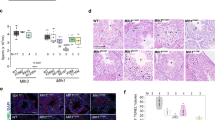Abstract
Hereditary non-polyposis colorectal cancer (HNPCC; OMIM 120435-6) is a cancer-susceptibility syndrome1 linked to inherited defects in human mismatch repair (MMR) genes2. Germline missense human MLH1 (hMLH1) mutations are frequently detected in HNPCC (ref. 3), making functional characterization of mutations in hMLH1 critical to the development of genetic testing for HNPCC. Here, we describe a new method for detecting mutations in hMLH1 using a dominant mutator effect of hMLH1 cDNA expressed in Saccharomyces cerevisiae. The majority of hMLH1 missense mutations identified in HNPCC patients abolish the dominant mutator effect. Furthermore, PCR amplification of hMLH1 cDNA from mRNA from a HNPCC patient, followed by in vivo recombination into a gap expression vector, allowed detection of a heterozygous loss-of-function missense mutation in hMLH1 using this method. This functional assay offers a simple method for detecting and evaluating pathogenic mutations in hMLH1.
This is a preview of subscription content, access via your institution
Access options
Subscribe to this journal
Receive 12 print issues and online access
$209.00 per year
only $17.42 per issue
Buy this article
- Purchase on Springer Link
- Instant access to full article PDF
Prices may be subject to local taxes which are calculated during checkout





Similar content being viewed by others
References
Lynch, H.T., Smyrk, T. & Lynch, J.F. Overview of natural history, pathology, molecular genetics and management of HNPCC (Lynch Syndrome). Int. J. Cancer 69, 38–43 (1996).
Liu, B. et al. Analysis of mismatch repair genes in hereditary non-polyposis colorectal cancer patients . Nature Med. 2, 169–174 (1996).
Peltomaki, P. et al. Mutations predisposing to hereditary nonpoplyposis colorectal cancer: Database and results of a collaborative study. Gastroenterology 113, 1146–1158 (1997).
Papadopoulos, N. et al. Mutation of a mutL homolog in hereditary colon cancer. Science 263, 1625–1629 ( 1994).
Liu, B. et al. hMSH2 mutations in hereditary nonpolyposis colorectal cancer kindreds. Cancer Res. 54, 4590–4594 (1994).
Ishioka, C. et al. Detection of heterozygous truncating mutations in the BRCA1 and APC genes by using a rapid screening assay in yeast. Proc. Natl Acad. Sci. USA 94, 2449–2453 (1997).
Kolodner, R. Biochemistry and genetics of eukaryotic mismatch repair. Genes Dev. 10, 1433–1442 (1996).
Henderson, S.T. & Petes, T.D. Instability of a plasmid-borne inverted repeat in Saccharomyces cerevisiae. Genetics 134, 57–62 (1993).
Strand, M., Prolla, T.A., Liskay, R.M. & Petes, T.D. Destabilization of tracts of simple repetitive DNA in yeast by mutations affecting DNA mismatch repair. Nature 365, 274– 276 (1993).
Sia, E.A., Kokoska, R.J., Dominska, M., Greenwell, P. & Petes, T.D. Microsatellite Instability in yeast: dependence on repeat unit size and DNA mismatch repair genes. Mol. Cell. Biol. 17, 2851–2858 ( 1997).
Ishioka, C. et al. Screening patients for heterozygous p53 mutations using a functional assay in yeast. Nature Genet. 5, 124– 129 (1993).
Pensotti, V. et al. Mean age of tumor onset in hereditary nonpolyposis colorectal cancer (HNPCC) families correlates with the presence of mutations in DNA mismatch repair genes. Genes Chromosomes Cancer 19, 135– 142 (1997).
Marsischky, G.T., Filosi, N., Kane, M.F. & Kolodner, R. Redundancy of Saccharomyces cerevisiae MSH3 and MSH6 in MSH2-dependent mismatch repair. Genes Dev. 10, 407– 420 (1996).
Reenan, R.A. & Kolodner, R.D. Characterization of insertion mutations in the Saccharomyces cerevisiae MSH1 and MSH2 genes: evidence for separate mitochondrial and nuclear functions. Genetics 132, 975–985 ( 1992).
Lea, D.E. & Coulson, C.A. The distribution of the number of mutants in bacterial populations. J. Genet. 49, 264–285 (1949).
Christianson, T.W., Sikorski, R.S., Dante, M., Shero, J.H. & Hieter, P. Multifunctional yeast high-copy-number shuttle vectors. Gene 110, 119– 122 (1992).
Sarkar, G. & Sommer, S.S. The "megaprimer" method of site-directed mutagenesis. Biotechniques 8, 404– 407 (1990).
Bronner, C.E. et al. Mutation in the DNA mismatch repair gene homologue hMLH1 is associated with hereditary non-polyposis colon cancer. Nature 368, 258–261 (1994).
Vasen, H.F. et al. The international collaborative group on hereditary non-polyposis colorectal cancer (ICG-HNPCC). Dis. Colon Rectum 34, 424–425 (1991).
Viel, A. et al. Characterization of MSH2 and MLH1 mutations in Italian families with hereditary nonpolyposis colorectal cancer. Genes Chromosomes Cancer 18, 8–18 ( 1997).
Acknowledgements
We are grateful to the patients who participated in this study. We thank T. D. Petes for providing the pSH31 plasmid, N. Papadopoulos and S. Mizutani for providing cDNA containing hMLH1 mutations and E. O'Neil for technical assistance. We also thank A. Yasui, T. Noda, M. Vidal, K. Umezu, T. Hunato, S. Ishii, S. Kure and A. Horii for helpful comments about this work. This work was supported in part by Grant-in Aids for Scientific Research and International Scientific Research (Joint Study) from the Ministry of Education, Science, Sports and Culture (C.I., S.H.F., R.D.K.), Grant-in Aid from the Ministry of Health and Welfare (C.I.), the Osaka Cancer Research Foundation (C.I.), the Tokyo Biochemical Research Foundation (C.I.), the Sapporo Bioscience Foundation (C.I.) and a National Institutes of Health grant, no. GM50006 (R.D.K.).
Author information
Authors and Affiliations
Corresponding authors
Rights and permissions
About this article
Cite this article
Shimodaira, H., Filosi, N., Shibata, H. et al. Functional analysis of human MLH1 mutations in Saccharomyces cerevisiae. Nat Genet 19, 384–389 (1998). https://doi.org/10.1038/1277
Received:
Accepted:
Issue Date:
DOI: https://doi.org/10.1038/1277
This article is cited by
-
Cmr1/WDR76 defines a nuclear genotoxic stress body linking genome integrity and protein quality control
Nature Communications (2015)
-
Determining the functional significance of mismatch repair gene missense variants using biochemical and cellular assays
Hereditary Cancer in Clinical Practice (2012)
-
Missense variants in hMLH1 identified in patients from the German HNPCC consortium and functional studies
Familial Cancer (2011)
-
Non-truncating hMLH1 variants identified in Slovenian gastric cancer patients are not associated with Lynch Syndrome: a functional analysis report
Familial Cancer (2011)
-
Expressing and functional analysis of mammalian apoptotic regulators in yeast
Cell Death & Differentiation (2010)



